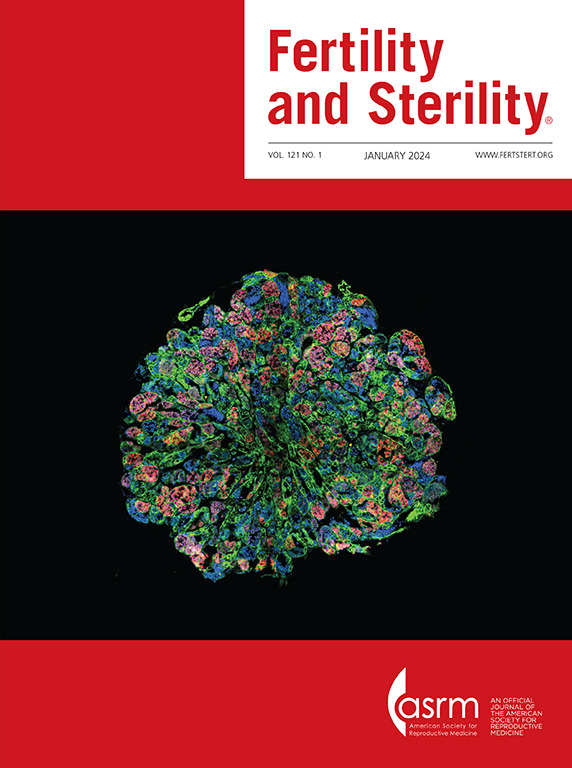子宫内膜厚度增加至12mm与有或没有PGT的新鲜和冻融自体移植的活产几率增加有关。
IF 6.6
1区 医学
Q1 OBSTETRICS & GYNECOLOGY
引用次数: 0
摘要
目的探讨子宫内膜厚度对自体辅助生殖周期中活产的影响。回顾性队列研究对象:2016-2018年向辅助生殖技术协会报告的所有接受自体周期移植的女性。在新鲜周期中排卵触发当天的子宫内膜厚度和在冻融周期中最接近胚胎移植的子宫内膜厚度主要结局指标:在8-11.9mm的参考范围内比较不同子宫内膜厚度的活产相对风险。采用广义估计方程进行对数二项回归,对年龄、BMI、吸烟、不孕病因、AMH和FSH进行校正。分别分析新鲜移植、未进行胚胎植入前基因检测的冻融移植和进行胚胎植入前基因检测的冻融移植。结果182,784例患者共进行了261,266次联合检索和转移周期。子宫内膜<8mm的患者年龄稍大,BMI较低,既往妊娠流产率较高,卵巢储备功能减退,除多囊卵巢综合征外还有排卵障碍,但男性或不明原因不孕的发生率较低。当所有新鲜和冻融移植联合使用时,活产率随子宫内膜厚度的增加而增加,从31.2% (<6mm)到34.4% (6-6.9mm)到40.8% (7-7.9mm)到45.0% (8-11.9mm)到46.4% (12-14.9mm)到46.2%(≥15mm)。对于没有植入前遗传学检测的新鲜周期,与8-11.9mm参考范围相比,较薄的子宫内膜与活产率降低相关(<6mm, 6-6.9mm和7-7.9mm的调整相对风险为0.59 (95% CI 0.48-0.72), 0.66(0.58-0.74), 0.79(0.74-0.84)),而12-14.9mm和≥15mm厚度与活产率增加相关(调整相对风险为1.12(1.09-1.15)和1.16(1.12-1.22))。对于厚度<6mm、6-6.9mm、7-7.9mm、12-14.9mm和≥15mm的冻融周期(调整相对风险为0.87(0.77-0.99)、0.79(0.73-0.85)、0.94(0.91-0.97)、1.06(1.03-1.08)和1.04(0.98-1.1))以及厚度<6mm、6-6.9mm、7-7.9mm的冻融周期(调整相对风险为0.67(0.59-0.77)、0.80(0.76-0.85)、0.89(0.87-0.92)、1.07(1.05-1.1)和1.06(1-1.11)),均有类似但不太显著的影响。12-14.9mm和≥15mm)。结论子宫内膜厚度从5 mm增加到8mm与活产率明显增加有关,但直到约12mm时仍能看到改善,包括植入前基因检测的冻融周期。本文章由计算机程序翻译,如有差异,请以英文原文为准。
Increasing Endometrial Thickness up to 12mm Is Associated with Increased Odds of Live Birth Among Fresh and Frozen-Thawed Autologous Transfers with or without PGT.
OBJECTIVE
To evaluate the impact of endometrial thickness on live birth among autologous assisted reproduction cycles.
DESIGN
Retrospective cohort SUBJECTS: All women undergoing autologous cycles with transfers in 2016-2018 reported to the Society for Assisted Reproductive Technology.
EXPOSURE
Endometrial thickness on the day of ovulation trigger in fresh cycles and closest to embryo transfer in frozen-thawed cycles MAIN OUTCOME MEASURES: Relative risk of live birth across endometrial thicknesses was compared with an 8-11.9mm reference range. Estimates were adjusted for age, BMI, smoking, infertility etiology, AMH and FSH with log-binomial regression by generalized estimating equations. Fresh transfers, frozen-thawed transfers without preimplantation genetic testing and frozen-thawed transfers with preimplantation genetic testing were analyzed separately.
RESULTS
182,784 patients underwent 261,266 combined retrieval and transfer cycles. Patients with endometrium <8mm were slightly older, with lower BMI, higher rates of prior pregnancy loss, diminished ovarian reserve and ovulation disorders besides polycystic ovarian syndrome but lower rates of male or unexplained infertility. When all fresh and frozen-thawed transfers were combined, live birth rate increased with endometrial thickness from 31.2% (<6mm) to 34.4% (6-6.9mm) to 40.8% (7-7.9mm) to 45.0% (8-11.9mm) to 46.4% (12-14.9mm) to 46.2% (≥15mm). For fresh cycles without preimplantation genetic testing, thinner endometrium was associated with reduced live birth rate compared with the 8-11.9mm reference range (adjusted relative risk 0.59 (95% CI 0.48-0.72), 0.66 (0.58-0.74), 0.79 (0.74-0.84) for thickness <6mm, 6-6.9mm and 7-7.9mm), while 12-14.9mm and ≥15mm thickness were associated with increased live birth rate (adjusted relative risk 1.12 (1.09-1.15) and 1.16 (1.12-1.22)). Similar but less dramatic effects were noted for frozen-thawed cycles without preimplantation genetic testing (adjusted relative risk 0.87 (0.77-0.99), 0.79 (0.73-0.85), 0.94 (0.91-0.97), 1.06 (1.03-1.08) and 1.04 (0.98-1.1) for thickness <6mm, 6-6.9mm, 7-7.9mm, 12-14.9mm, and ≥15mm) and frozen-thawed cycles with preimplantation genetic testing (adjusted relative risk 0.67 (0.59-0.77), 0.80 (0.76-0.85), 0.89 (0.87-0.92), 1.07 (1.05-1.1), and 1.06 (1-1.11) for thickness <6mm, 6-6.9mm, 7-7.9mm, and 12-14.9mm and ≥15mm).
CONCLUSION
Increasing endometrial thickness from 5 to 8mm is associated with clear increases in live birth rate, but improvements are still seen until approximately 12mm, including frozen-thawed cycles with preimplantation genetic testing.
求助全文
通过发布文献求助,成功后即可免费获取论文全文。
去求助
来源期刊

Fertility and sterility
医学-妇产科学
CiteScore
11.30
自引率
6.00%
发文量
1446
审稿时长
31 days
期刊介绍:
Fertility and Sterility® is an international journal for obstetricians, gynecologists, reproductive endocrinologists, urologists, basic scientists and others who treat and investigate problems of infertility and human reproductive disorders. The journal publishes juried original scientific articles in clinical and laboratory research relevant to reproductive endocrinology, urology, andrology, physiology, immunology, genetics, contraception, and menopause. Fertility and Sterility® encourages and supports meaningful basic and clinical research, and facilitates and promotes excellence in professional education, in the field of reproductive medicine.
 求助内容:
求助内容: 应助结果提醒方式:
应助结果提醒方式:


